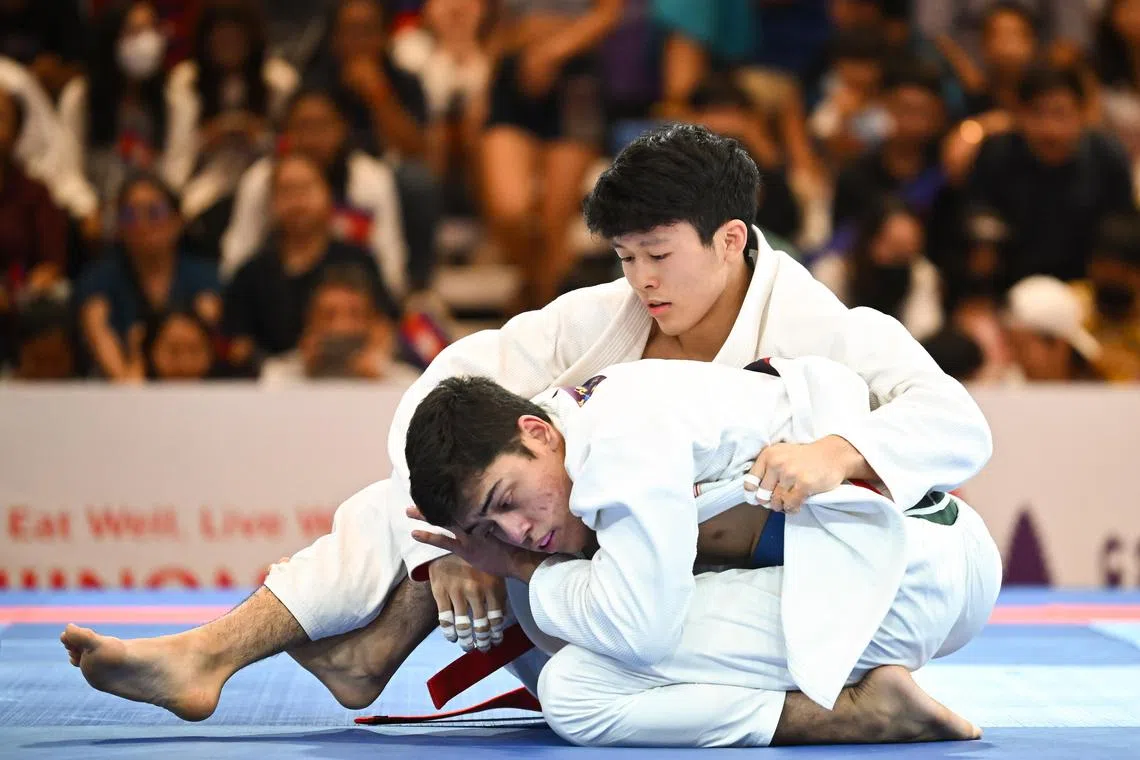Five things to know about ju-jitsu
Sign up now: Get the biggest sports news in your inbox

Noah Lim (top) won Singapore's first gold medal at the Cambodia SEA Games in the men's ne-waza gi under-69kg on Saturday.
ST PHOTO: LIM YAOHUI
Follow topic:
SINGAPORE – Ju-jitsu athlete Noah Lim won the Republic’s first gold medal at the 2023 SEA Games
With different forms of martial arts such as Brazilian ju-jitsu and submission grappling growing in popularity, here are five things to know about ju-jitsu.
1. Ju-jitsu translates to “gentle art”
Ju means gentle or yielding, whereas jitsu refers to arts or technique.
The martial art focuses on the idea of defeating stronger opponents with a flexible fighting strategy.
2. It was developed in Japan for the samurai
The traditional form of ju-jitsu, Japanese jujutsu, was developed for military combat use for samurai on the battlefield.
Developed along fighting disciplines such as archery and swordsmanship, ju-jitsu was used in close combat in cases when samurais lost their weapons. They would defend themselves with moves such as joint locks and chokeholds.
Newer forms of martial arts such as judo, aikido and Brazilian ju-jitsu emerged over the years as different masters developed the traditional art form while incorporating techniques of their own.
3. Athletes compete in different types of ju-jitsu events
There are three variants in the sport: the Duo, the Fighting System and the ne-waza.
In Duo, both attacker and defender are from the same team and demonstrate self-defence techniques.
For the Fighting System, fighters can use striking, grappling and submission techniques.
The ne-waza variation focuses on grappling and participants work for a submission. Striking actions such as punches and kicks are prohibited. The win is decided by submission or points, which are awarded for actions such as throws, takedowns or gaining an advantageous position over the opponent.
4. Competitions can take place both with or without a gi
There are two formats for ju-jitsu events – gi and no-gi. In gi events, participants have to wear a traditional uniform known as gi, consisting of thick cotton garments and a coloured belt.
For no-gi events, they typically trade their uniform for a tight spandex shirt known as a rashguard.
In no-gi events, athletes are unable to use their opponent’s clothing to control their attacks. They are also unable to grip the collar or sleeves to set up an offensive action.
Three-time SEA Games gold medallist Noah Lim will be competing in the ne-waza no-gi under-69kg event on Sunday.
5. Over 20 techniques are listed as prohibited
Based on rules by the Ju-Jitsu International Federation, varying numbers of techniques are disallowed based on age, level and belt divisions. For novices under the age of 12, 26 techniques are not permitted.
Moves prohibited across all divisions include spinal locks, heel hooks and scissor takedowns. Fighters are also not allowed to apply pressure on their opponent’s foot while performing a toe hold on them or bending their fingers backwards.


